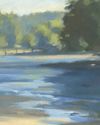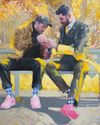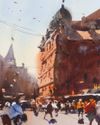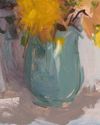With the first UK show of his work in the medium in more than 100 years opening in June, Sally Hales talks to Richard Ormond , the artist’s grand-nephew and the exhibition’s co-curator, about what the paintings meant to the man and his craft

The Anglo-American artist perches uncomfortably on a steep slope of the Simplon Pass, high in the Swiss Alps, feet wedged precariously against rocks. Brush and palette in hand, and surrounded by the high-tech kit of the times – telescopic easel, paintbox – he looks rather more like an Edwardian explorer than the most famous society portrait painter of his age.
Yet John Singer Sargent, celebrated for the luminous, technical brilliance of his oil portraits, worked en plein air in watercolor throughout his life. Indeed, in his later years, he painted in the medium almost obsessively on regular travels through Europe and beyond. The resulting works, however, have often been dismissed as mere travel souvenirs. Now, a show at London’s Dulwich Picture Gallery – the first UK exhibition of Sargent’s watercolors in more than 100 years – is set to overturn that impression. “I always think the watercolors have been underplayed,” says Richard Ormond, the artist’s grand-nephew and an art historian who has co-curated Sargent: The Watercolors, which runs from 21 June to 8 October 2017, with Elaine Kilmurray. The exhibition collects more than 80 works from 30 lenders – many never before seen in public – to showcase the painter’s fluency in watercolor, as well as highlight the seriousness with which he took the medium. “He put a lot of effort into them and, in his later years, he was as much a watercolorist as he was an oil painter.”
Denne historien er fra July 2017-utgaven av Artists & Illustrators.
Start din 7-dagers gratis prøveperiode på Magzter GOLD for å få tilgang til tusenvis av utvalgte premiumhistorier og 9000+ magasiner og aviser.
Allerede abonnent ? Logg på
Denne historien er fra July 2017-utgaven av Artists & Illustrators.
Start din 7-dagers gratis prøveperiode på Magzter GOLD for å få tilgang til tusenvis av utvalgte premiumhistorier og 9000+ magasiner og aviser.
Allerede abonnent? Logg på

Still life IN 3 HOURS
Former BP Portrait Award runner-up FELICIA FORTE guides you through a simple, structured approach to painting alla prima that tackles dark, average and light colours in turn

Movement in composition
Through an analysis of three masterworks, landscape painter and noted author MITCHELL ALBALA shows how you can animate landscape composition with movement

Shane Berkery
The Irish-Japanese artist talks to REBECCA BRADBURY about the innovative concepts and original colour combinations he brings to his figurative oil paintings from his Dublin garden studio

The Working Artist
Something old, something new... Our columnist LAURA BOSWELL has expert advice for balancing fresh ideas with completing half-finished work

Washes AND GLAZES
Art Academy’s ROB PEPPER introduces an in-depth guide to incorporating various techniques into your next masterpiece. Artwork by STAN MILLER, CHRIS ROBINSON and MICHELE ILLING

Hands
LAURA SMITH continues her new four-part series, which encourages you to draw elements of old master paintings, and this month’s focus is on capturing hands

Vincent van Gogh
To celebrate The Courtauld’s forthcoming landmark display of the troubled Dutch master’s self-portraits, STEVE PILL looks at the stories behind 10 of the most dramatic works on display

BRING THE drama
Join international watercolour maestro ALVARO CASTAGNET in London’s West End to paint a dramatic street scene

Serena Rowe
The Scottish painter tells STEVE PILL why time is precious, why emotional responses to colour are useful, and how she finds focus every day with the help of her studio wall

Bill Jacklin
Chatting over Zoom as he recovers from appendicitis, the Royal Academician tells STEVE PILL about classic scrapes in New York and his recent experiments with illustration